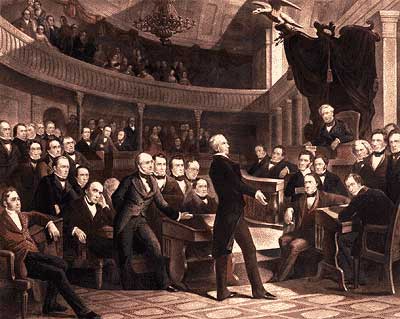
Henry Clay (center, standing) introduced the Compromise of 1850.
In 1850, Henry Clay proposed a plan known as the Compromise of 1850. There were five major parts of the plan: California would enter the Union as a free state, New Mexico and Utah would decide on slavery using popular sovereignty, The Republic of Texas would relinquish lands in New Mexico and receive money to pay off their debts to Mexico, slave trade was banned in Washington D.C., and the Fugitive Slave Act was passed. After much debate, Congress didn't pass Clay's compromise. However, Stephen A. Douglas divided the five parts of the pan into separate bills, thus allowing them to be voted on individually. By fall of 1850, Congress had passed all parts of Compromise of 1850.
The Compromise of 1850 succeeded in easing the tensions over slavery for a short time, further postponing the Civil War. It held a continued equal balance between the slave states supporters and the northern anti-slavery supporters.
In 1850, Henry Clay proposed a plan known as the Compromise of 1850. There were five major parts of the plan: California would enter the Union as a free state, New Mexico and Utah would decide on slavery using popular sovereignty, The Republic of Texas would relinquish lands in New Mexico and receive money to pay off their debts to Mexico, slave trade was banned in Washington D.C., and the Fugitive Slave Act was passed. After much debate, Congress didn't pass Clay's compromise. However, Stephen A. Douglas divided the five parts of the pan into separate bills, thus allowing them to be voted on individually. By fall of 1850, Congress had passed all parts of Compromise of 1850.
The Compromise of 1850 succeeded in easing the tensions over slavery for a short time, further postponing the Civil War. It held a continued equal balance between the slave states supporters and the northern anti-slavery supporters.
No comments:
Post a Comment